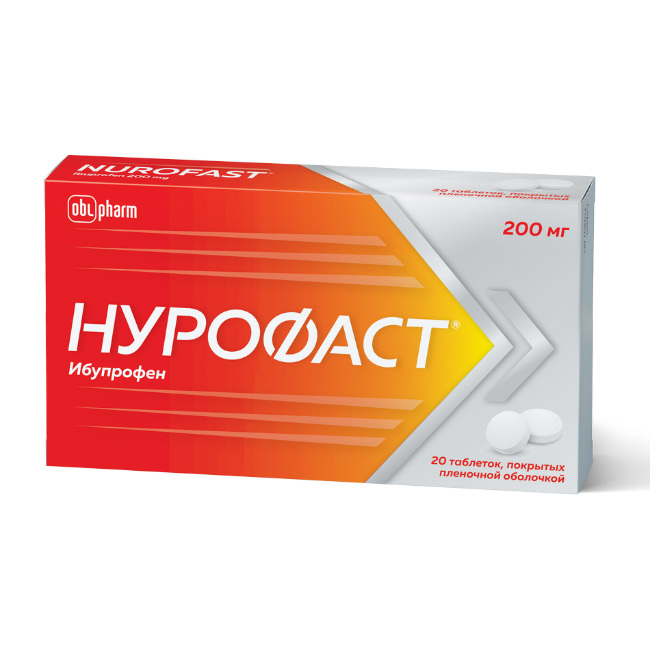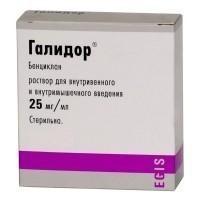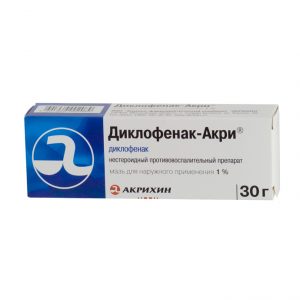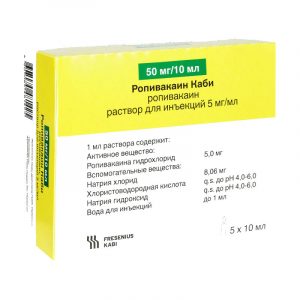Description
Release form Pharmacology groups of non-steroidal anti-inflammatory drugs (NSAIDs), due to inhibition of the synthesis of prostaglandins – mediators of pain, inflammation and hyperthermia. Indirectly blocks cyclooxygenase 1 (COX-1) and cyclooxygenase 2 (COX-2), as a result of which it inhibits prostaglandin synthesis.
It has a quick directed action against pain (analgesic), antipyretic and anti-inflammatory effect. In addition, ibuprofen reversibly inhibits platelet aggregation. The analgesic effect of the drug lasts up to 8 hours.
Pharmacokinetics
Absorption – high, rapidly and almost completely absorbed from the gastrointestinal tract (GIT). After taking the drug on an empty stomach, the maximum concentration (Cmax) of ibuprofen in blood plasma is reached after 45 minutes. Taking the drug with food can increase the time to reach maximum concentration (TCmax) up to 1-2 hours.
Communication with plasma proteins – 90%. Slowly penetrates into the joint cavity, lingers in the synovial fluid, creating higher concentrations in it than in blood plasma. Lower concentrations of ibuprofen are found in the cerebrospinal fluid compared with blood plasma. After absorption, about 60% of the pharmacologically inactive R-form slowly transforms into the active S-form. It is metabolized in the liver. The half-life (T1 / 2) is 2 hours. It is excreted by the kidneys (unchanged no more than 1%) and, to a lesser extent, with bile.
In limited studies, ibuprofen was found in breast milk at very low concentrations.
Indications
Nurofast ® is used for headaches, migraines, toothaches, painful periods, neuralgia, back pain, muscle pain, rheumatic pain and joint pain as well as in a febrile state with flu and colds.
Contraindications
Hypersensitivity to ibuprofen or any of the components that make up the drug.
Complete or incomplete combination of bronchial asthma, recurrent nasal polyposis and paranasal sinuses and intolerance to acetylsalicylic acid or other NSAIDs (including a history).
Erosive and ulcerative diseases of the gastrointestinal tract (including gastric and duodenal ulcers, Crohn’s disease, ulcerative colitis) or ulcerative bleeding in the active phase or in the anamnesis (two or more confirmed episodes of peptic ulcer or ulcer bleeding).
History of bleeding or perforation of a gastrointestinal ulcer provoked by the use of NSAIDs.
Severe heart failure (NYHA Class IV – Classification of the New York Association of Cardiology).
Severe liver failure or liver disease in the active phase.
Severe renal failure (creatinine clearance <30 ml / min), confirmed hyperkalemia. Decompensated heart failure period after coronary artery bypass grafting. Cerebrovascular or other bleeding. Hemophilia and other bleeding disorders (including hypocoagulation), hemorrhagic diathesis. Pregnancy (III trimester). Children under 6 years old. Caution If you have the conditions mentioned in this section, you should consult your doctor before using the drug. Concomitant use of other NSAIDs, the presence in the history of a single episode of gastric and duodenal ulcer or gastric ulcer bleeding gastritis, enteritis, colitis, the presence of Helicobacter pylori infection, ulcerative colitis, bronchial asthma or allergic diseases in the acute stage or in the anamnesis – it is possible to develop bronchospasm or systemic lupus erythematosus tissue (Sharpe syndrome) – increased risk of aseptic meningitis chickenpox renal failure, including with dehydration (creatinine clearance less than 30-6 0 ml / min), nephrotic syndrome, liver failure, liver cirrhosis with portal hypertension, hyperbilirubinemia, arterial hypertension and / or heart failure, cerebrovascular diseases, blood diseases of unknown etiology (leukopenia and anemia), severe somatic diseases, dyslipidemia / hyperlipidemia, diabetes mellitus, peripheral arterial disease, smoking, frequent alcohol consumption, the simultaneous use of drugs that can increase the risk of ulcers or bleeding, in particular oral glucocorticosteroids (including prednisone), anticoagulants (including warfarin) selective serotonin reuptake inhibitors (including citalopram, fluoxetine, paroxetine, sertraline) or antiplatelet agents (including acetylsalicylic acid, clopidogrel ), pregnancy I-II trimester, the period of breastfeeding, old age, age under 12 years. Special instructions It is recommended to take the drug as soon as possible in the shortest possible time and at the minimum effective dose necessary to eliminate the symptoms. If you need to take the drug for more than 10 days, you must consult a doctor. In patients with bronchial asthma or an allergic disease in the acute stage, as well as in patients with a history of bronchial asthma / allergic disease, the drug can provoke bronchospasm. The use of the drug in patients with systemic lupus erythematosus or mixed connective tissue disease is associated with an increased risk of developing aseptic meningitis. During prolonged treatment, monitoring of the peripheral blood picture and the functional state of the liver and kidneys is necessary. When symptoms of gastropathy appear, careful monitoring is indicated, including esophagogastroduodenoscopy, a general blood test (determination of hemoglobin), fecal occult blood analysis. If it is necessary to determine 17-ketosteroids, the drug should be discontinued 48 hours before the study. During treatment, ethanol is not recommended. Patients with renal failure should consult a doctor before using the drug, since there is a risk of impaired renal function. Patients with hypertension, including a history of and / or chronic heart failure, should consult a doctor before using the drug, since the drug can cause fluid retention, increased blood pressure and swelling. Patients with uncontrolled arterial hypertension, NYHA class II-III congestive heart failure, coronary heart disease, peripheral artery disease and / or cerebrovascular disease should be prescribed ibuprofen only after a careful assessment of the benefit-risk ratio, and the use of high doses of ibuprofen should be avoided ( 2400 mg / day). NSAIDs in patients with chickenpox may be associated with an increased risk of developing severe purulent complications of infectious and inflammatory diseases of the skin and subcutaneous fat (e.g., necrotizing fasciitis). In this regard, it is recommended to avoid the use of the drug for chickenpox. Information for women planning a pregnancy: the drug suppresses cyclooxygenase and prostaglandin synthesis, affects ovulation, disrupting female reproductive function (reversible after canceling treatment). Effects on ability to drive vehicles and mechanisms Patients with dizziness, drowsiness, lethargy, or visual impairment while taking ibuprofen should avoid driving or operating machinery. Composition of 1 film-coated tablet contains: active ingredient: ibuprofen – 200 mg excipients: sodium croscarmellose, sodium citrate dihydrate, srdlklp sodium sildlklp sodium di sodium sulfide sulfide stearic acid coating aids: Opadry II 85F48105 white (polyvinyl alcohol, macrogol, talc, titanium dioxide). Dosage and administration For oral administration. Patients with increased gastric sensitivity are recommended to take the drug with meals. For short-term use only. Read the instructions carefully before taking the drug. Adults and children over 12 years of age: Inside, 1 tablet (200 mg) up to 3-4 times a day. Tablets should be washed down with water. To achieve a faster therapeutic effect in adults, the dose can be increased to 2 tablets (400 mg) up to 3 times a day. For children from 6 to 12 years: 1 tablet (200 mg) up to 3-4 times a day, the drug can be taken only if the child’s body weight is more than 20 kg. The interval between taking the tablets should be at least 6 hours. The maximum daily intake for adults is 1200 mg (6 tablets). The maximum daily dose for children from 6 to 18 years is 800 mg (4 tablets). If, after taking the drug for 2 3 days, symptoms persist or intensify, stop treatment and consult a doctor. Side effects The risk of side effects can be minimized by taking the drug in a short course, at the minimum effective dose needed to eliminate the symptoms. Elderly people have an increased frequency of adverse reactions with NSAIDs, especially gastrointestinal bleeding and perforations, in some cases fatal. Side effects are predominantly dose dependent. The following adverse reactions have been observed with short-term use of ibuprofen in doses not exceeding 1200 mg / day (6 tablets). In the treatment of chronic conditions and with prolonged use, other adverse reactions may occur. The frequency of adverse reactions was estimated based on the following criteria: very frequent ( 1/10), frequent (from 1/100 to <1/10), infrequent (from 1/1000 to <1/100), rare (from 1/10000 to <1/1000), very rare (1/10000), the frequency is unknown (there is not enough data to estimate the frequency). Disorders of the blood and lymphatic system · Very rare: hematopoiesis (anemia, leukopenia, aplastic anemia, hemolytic anemia, thrombocytopenia, pancytopenia, agranulocytosis). The first symptoms of these disorders are fever, sore throat, superficial oral ulcers, flu-like symptoms, severe weakness, nosebleeds, and subcutaneous hemorrhages, bleeding, and bruising of unknown etiology. Immune system disorders · Infrequent: hypersensitivity reactions – non-specific allergic reactions and anaphylactic reactions, reactions from the respiratory tract (bronchial asthma, including exacerbation, bronchospasm, shortness of breath, dyspnea), skin reactions (itching, urticaria, purpura , Quincke’s edema, exfoliative and bullous dermatoses, including toxic epidermal necrolysis (Lyell syndrome), Stevens-Johnson syndrome, erythema multiforme), allergic rhinitis, eosinophilia. · Very rare: severe hypersensitivity reactions, including swelling of the face, tongue and larynx, shortness of breath, tachycardia, arterial hypotension (anaphylaxis, Quincke’s edema, or severe anaphylactic shock). Gastrointestinal disorders · Infrequent: abdominal pain, nausea, dyspepsia (including heartburn, bloating). · Rare: diarrhea, flatulence, constipation, vomiting. · Very rare: peptic ulcer, perforation or gastrointestinal bleeding, melena, bloody vomiting, in some cases fatal, especially in elderly patients, ulcerative stomatitis, gastritis. · Unknown frequency: exacerbation of colitis and Crohn’s disease. Violation of the liver and biliary tract · Very rare: impaired liver function, increased activity of ² Ñliver ² Ñ transaminases, hepatitis and jaundice. Violation of the kidneys and urinary tract · Very rare: acute renal failure (compensated and decompensated) especially with prolonged use, combined with an increase in the concentration of urea in the blood plasma and the appearance of edema, hematuria and proteinuria, nephritic syndrome, nephrotic syndrome, papillary necrosis, interstitial nephritis, cystitis. Disorders of the nervous system · Infrequent: headache. · Very rare: aseptic meningitis. Cardiovascular disorders · Frequency unknown: heart failure, peripheral edema, prolonged use increases the risk of thrombotic complications (eg, myocardial infarction), increased blood pressure. Violation of the respiratory system and mediastinal organs · Frequency unknown: bronchial asthma, bronchospasm, shortness of breath. Laboratory indicators · hematocrit or hemoglobin (may decrease) · bleeding time (may increase) · plasma glucose concentration (may decrease) · creatinine clearance (may decrease) · plasma creatinine concentration (may increase) activity of hepatic transaminases (may increase) If side effects occur, you should stop taking the drug and consult a doctor. Overdose of In children, overdose symptoms may occur after taking a dose in excess of 400 mg / kg body weight. In adults, the dose-dependent effect of an overdose is less pronounced. The half-life of the drug with an overdose is 1.5-3 hours. Symptoms: nausea, vomiting, epigastric pain or, less commonly, diarrhea, tinnitus, headache, and gastrointestinal bleeding. In more severe cases, manifestations from the central nervous system are observed: drowsiness, rarely – agitation, convulsions, disorientation, coma. In cases of severe poisoning, metabolic acidosis and an increase in prothrombin time, renal failure, damage to liver tissue, lowering blood pressure, respiratory depression and cyanosis can develop. In patients with bronchial asthma, an exacerbation of this disease is possible. Treatment: symptomatic, with mandatory airway management, ECG monitoring and basic vital signs up to the normalization of the patient’s condition. Oral administration of activated charcoal or gastric lavage within 1 hour after taking a potentially toxic dose of ibuprofen is recommended. If ibuprofen has already been absorbed, an alkaline drink may be prescribed to excrete the acid derivative of ibuprofen by the kidneys, forced diuresis. Frequent or prolonged seizures should be stopped by the intravenous administration of diazepam or lorazepam. If bronchial asthma worsens, the use of bronchodilators is recommended. Storage conditions Store at a temperature not exceeding 25 ° C. Keep out of the reach of children. Expiration 3 years. Deystvuyuschee substances Ibuprofen Conditions of release from pharmacies Without a prescription dosage form tablets




